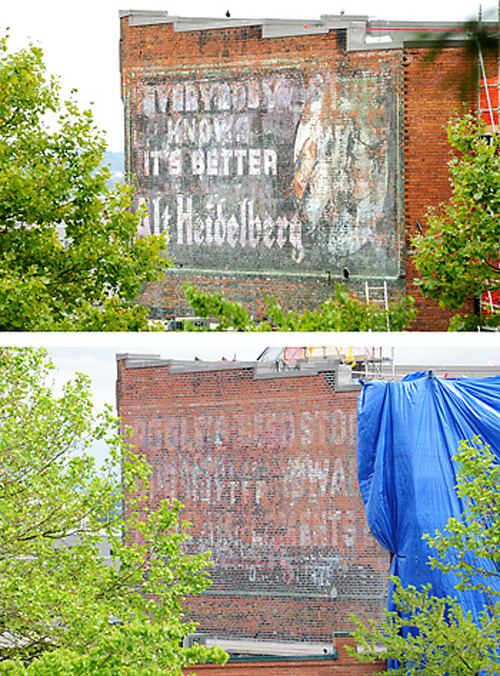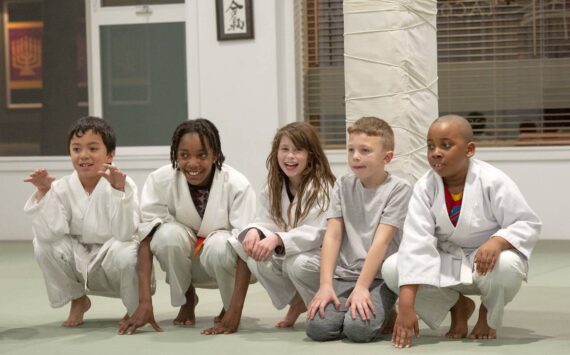The architecture firm responsible for destroying a “ghost mural” that once covered the north end of a historic building in downtown Tacoma and prominently displayed the logo of a former Tacoma brewery recently appeared before Tacoma’s Landmarks Preservation Commission (LPC) to apologize for the error.
“We understand that we blew it,” said Kacey Jurgens, a principal at THA Architecture. She spoke during the LPC’s meeting June 9. “We had a [specification] that said this sign was to be preserved. As you can imagine, we were a little shocked when it wasn’t. We take full responsibility.”
On May 27, the University of Washington Tacoma (UWT) announced that during the $34 million renovation of the Russell T. Joy Building, located at 1716-1730 Pacific Avenue on the university’s downtown campus, the Alt Heidelberg ghost mural, with its faded image of the Student Prince toasting a pint of the brewery’s namesake beer, was wiped clean when a contractor working for Korsmo Construction pressure washed the building and its mural.
According to UWT officials, the ghost mural is believed to be one of the last Alt Heidelberg signs in existence.
“I think the Student Prince was probably one of the most iconic visual view gateway pieces,” said City of Tacoma Historic Preservation Officer Reuben McKnight. “It’s not just a run of the mill sign.”
“[The pressure washer was] set to the strength of a garden hose,” said UWT spokesman Mike Wark in a statement. “This is the same procedure that was used on our other ghost murals, and no paint solvents were used. The paint was extremely flaky and loose and was not adhering to the bricks. This procedure is normally used in brick restoration so that the bricks can be re-pointed with new mortar.”
“UWT is working closely with all the parties involved to determine how any of us might have been able to prevent this,” added Chancellor Pat Spakes. “We are deeply saddened by the loss of this historic relic. We weren’t expecting this. It’s like losing an old friend.”
The Joy Building is located within the Union Depot / Warehouse Historic District, which is listed on the Tacoma and National Registers of Historic Places. Russell T. Joy came to Tacoma in 1888 and worked as a clerk for the Tacoma Land Company. Soon after, he went into business as a builder and real estate developer. In 1892, he commissioned three buildings to be constructed in the Warehouse District, including the one that bears his name. The architects were Pickles and Sutton, a firm that designed many distinguished buildings in Tacoma, including the National Bank of Tacoma.
Mr. Joy’s namesake building has been home to a wide variety of industry, including a wholesale grocery, a paper company, a stove manufacturing business, a candy company, a glove maker, and a number of automobile-related businesses, including a Firestone Tire store and both Studebaker and Oldsmobile distributors. The Joy Building renovation currently under way is expected to be completed in spring 2011.
On June 9, landmarks commissioners and representatives of UWT and THA Architecture addressed the issue in a lengthy conversation that covered a range of concerns related to the mural. Here is an excerpt of that discussion.
I. Kacey Jurgens, THA Architecture
To begin with, there are really four major parties that have been involved in this: the University of Washington Tacoma, [the Capital Projects Office] from the Seattle campus, ourselves [at] THA Architecture, and, of course, Korsmo Construction. There are some other minor players in all of this, but we are the four responsible parties. We understand that we blew it. It’s been very stressful for everybody. Derek deVille, who’s not here today, he’s the project manager, has lost many nights of sleep over what we could have done. We’ve all talked a number of times at meetings really tying to understand what happened and why this happened and why we lost the sign. Including Korsmo, we were all just shocked when the tarps came down and the sign was no longer there. We looked at our [specifications] to begin with to see what we did. Did we do something differently than we had before on these signs? It was basically the same step we used on the [UWT] assembly hall that went all fine and dandy.
We really had no idea how fragile the sign was. In hindsight, I’m kicking myself that somehow we hadn’t gotten that information. We totally agreed that we could have had tighter [specifications]. We had a [specification] that said this sign was to be preserved. As you can imagine, we were a little shocked when it wasn’t. We take full responsibility.
Also, the campus has talked about how they have been so successful with all the other signs on campus, there was a level of complacency that we all had and we should have really highlighted it a lot more, really talked with the contractor a lot more about how important it was to preserve that. So we’re all taking a certain level of responsibility for that.
I think what was hard for Korsmo [Construction] was that because there was so much lead paint — and I know there have been issues about the whole thing was covered up, it happened three months ago, or two months ago, and supposedly nobody knew about it — it was because it was a contaminated area and they have been extraordinary in terms of dealing with safety issues. I mean, they are really a great group of people who have put their hearts into this project. Every time anybody goes in that area, you have to suit up, you have to clean up afterwards. They talked about how they didn’t go in because they had a relationship with the same subcontractor that did other work with them, with us, with the campus before, and they just didn’t realize what was happening. They are kicking themselves — Why didn’t we suit up and go in and see what happened? I’m not convinced that would have changed anything because it probably happened pretty quickly, which is what I’m gathering.
There’s nothing that we can do obviously at this point. The sign is gone. What we need to do is learn, really in the future, how to — and not necessarily with signage but with any historic feature in buildings that are on the campus — what are the next steps we take?
One of the things we do with Michael [Sullivan of Artifacts Consulting] is that he comes in really early on the project, before we even start schematic designs. He did an historic assessment on a number of the buildings we were looking at, and we go back and look at that but because he’s meeting certain criteria, the level of fragility of that sign was not really indicated. It just looked like all the other signs we have dealt with, which we’ve dealt with successfully. So we talked to him about what was the next step.
We really should have gotten [the Landmarks Preservation Commission] involved once we got into [the] design [phase] to talk more about the particular elements. Obviously, we brought somebody in on the windows, but we didn’t bring him in on the signage. I think that was an oversight on our part. We should have done that.
I’m sure [the ghost mural] could be recreated. Michael [Sullivan] thinks that’s not the right thing to do. I think everybody has a different attitude about whether recreating the sign is the right thing to do. The campus has talked about a variety of different things. Everything from a photographic expose inside the building of that sign, the history of the sign, and the mistakes that we made during construction so that it really becomes an educational opportunity.
II. Pamela Sundell, Landmarks Preservation Commissioner
Could [the sign] not be recreated? I agree with Michael Sullivan in that sense because it’s new, it’s a reproduction, not an original. But it’s a very visible sign. It’s right at the end of Pacific. What’s there now looks very muddy and unkempt. It doesn’t have a nice visual. I’m thinking more of the aesthetic than the historic. I don’t know which is better.
III. Milt Tremblay, University of Washington Tacoma Director of Facilities and Campus Services
Since this has happened, I have been checking the blogs nationwide. Part of the beauty of ghost signs, according to the blogs, is it’s changing. It’s documenting time. One of the things we’ve looked at in our guidelines is where do we want to stop the clock. Michael mentioned the other day we want to stop it at the point that it’s at when we take it over. This [Heidelberg ghost mural] is [from] 1933. It was very significant. I think we all realize that. When we did our walk-around early on in the project, one of the things we really wanted to pay attention to was which heritage elements could we show the future. We did salvage the hoist machinery we identified in our walk-through and will be installing it above the stairwell with some kind of ‘this is what this was’ kind of thing. And we have salvaged several of the metal fire separation doors that we’ll be installing. This has just been one of those really difficult and unfortunate incidents for all of us.
IV. Reuben McKnight, City of Tacoma Historic Preservation Officer
Ghost signs themselves are artifacts almost distinct from the buildings. The building has its life. The ghost signs have their lives. The one thing from a conservation point of view that is so problematic about ghost signs is that if you’re forced to make one decision over another, then you are also forced to destroy or lose something. I think that there is a lot of sentiment. People have commented to me about restore the sign or don’t restore the sign. Part of the significance of these signs is the fact that you can see multiple layers as they degrade. We’ve had signs that were recreated. On the side of the Pythian Temple there is the New York Outfitting Clothier Company sign, which was a commissioned restoration. You can really see that’s almost Technicolor compared to what an original sign in place looks like. I don’t know if it would be something for the commission to think about. At any rate, just from the preservation side of things, I think you’d just quit at this point in terms of doing treatments on the wall and instead just stabilize what is there.
V. Ken House, Landmarks Preservation Commissioner
I think you’ve been really frank. We’re not having a BP discussion here where you’re pointing fingers at other people. I think you said you blew it, it was stressful. I want to acknowledge you blew it. If you came back and I was on the commission and there was a sign involved, I would want a very detailed plan. If you don’t have it, I’m not going to vote for your project. It sounds like you didn’t manage it very well. For the record, you blew it. I appreciate you being frank. But I also don’t want to pass that acknowledgement and move on to remediation without getting that said.
– – – – – – – – – – – – – – – – – – –
For related Tacoma Daily Index coverage, click on the following links:
Building renovation destroys historic ghost mural (06/01/10) — http://tacomadailyindex.com/portals-code/list.cgi?paper=88&cat=23&id=1780198&more=0
Demolition begins on UW Tacoma’s Joy Building (08/21/09) — http://tacomadailyindex.com/portals-code/list.cgi?paper=88&cat=23&id=1610185&more=0
State budget troubles could tweak UWT Joy Building renovation (07/24/09) — http://tacomadailyindex.com/portals-code/list.cgi?paper=88&cat=23&id=1593473&more=0
A new chapter for historic downtown building (03/03/09) — http://tacomadailyindex.com/portals-code/list.cgi?paper=88&cat=23&id=1499499&more=0 and http://i.feedtacoma.com/TDI-Reporters-Notebook/new-chapter-historic-joy-building-001/
Vote clears way for UWT Joy Building early-phase renovations (02/27/09) — http://tacomadailyindex.com/portals-code/list.cgi?paper=88&cat=23&id=1498745&more=0
Tacoma’s Landmarks Preservation Commission will hear UWT Joy Building renovation plans (02/20/09) — http://tacomadailyindex.com/portals-code/list.cgi?paper=88&cat=23&id=1493209&more=0








